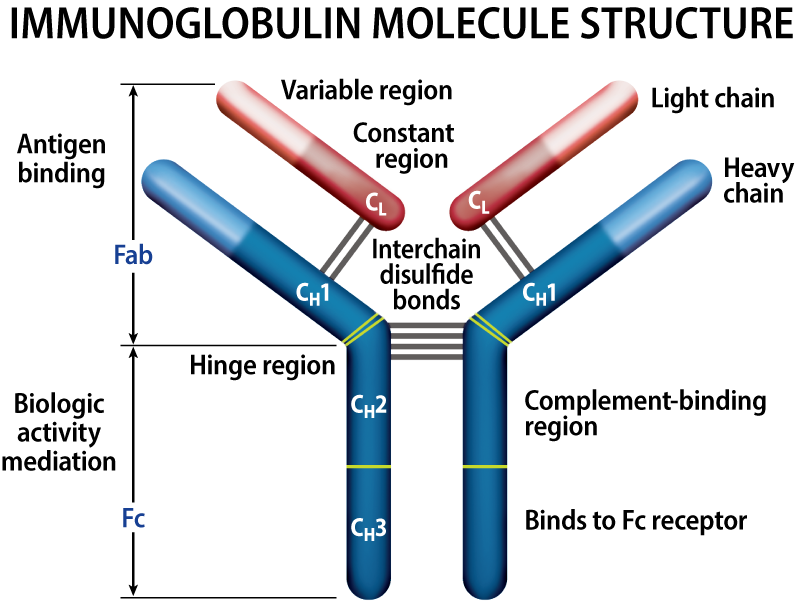Multiple myeloma has different types and subtypes. These types are based on the immunoglobulin (protein) produced by the myeloma cell. The various immunoglobulins have different functions in the body. Each immunoglobulin is made up of two heavy chains and two light chains.
The five types of heavy protein chains are G, A, D, E, and M.
The two types of light protein chains are kappa (κ) and lambda (λ).
Furthermore, there are different subtypes of myeloma.
Subtypes of immunoglobulins
| IgG kappa |
| IgA kappa |
| IgD kappa |
| IgE kappa |
| IgM kappa |
| IgG lambda |
| IgA lambda |
| IgD lambda |
| IgE lambda |
| IgM lambda |
- Normal plasma cells secrete immunoglobulins (antibodies) to fight infections. Immunoglobulins are proteins that attach to substances entering the body that the body recognizes as foreign. Normal immunoglobulins are called "polyclonal protein." Myeloma cells, which are cancerous plasma cells, secrete monoclonal protein. Monoclonal protein is an abnormal immunoglobulin that cannot properly fight infection.
- Healthy plasma cells or myeloma cells can produce immunoglobulins. These immunoglobulins made up of two heavy chains and two light chains that are bound together.

- The five possible types of immunoglobulin (abbreviated "Ig") are heavy chains: IgG, IgA, IgD, IgE, and IgM.
- The possible types of light chains are either kappa (κ) or lambda (λ).
- Myeloma cells make immunoglobulins. These immunoglobulins are made up of only one type of heavy chain (G, A, D, E, or M) and one type of light chain (kappa or lambda). The most common type of myeloma is IgG kappa. In IgG kappa myeloma, the myeloma cells produce an immunoglobulin made from two IgG heavy chains bound to two kappa light chains.
- About 15% of patients have light chain myeloma. In this type of myeloma, the myeloma cells secrete only light chain protein and no heavy chains. It is also known as "Bence-Jones myeloma" (after the doctor who discovered it).
- One to two-percent of patients have "non-secretory myeloma." In non-secretory myeloma, the myeloma cells produce very little or no monoclonal protein of any type.
- Your doctor will order tests to identify your type of myeloma. It's important to know which type you have as you will be able to better understand your test results.You will be able to determine if your level of monoclonal protein is stable, increasing, or decreasing.
See the IMF's Patient Handbook if you have been diagnosed with any of the following:
- AL amyloidosis
- Light chain deposition disease (LCDD)
- Waldenström's macroglobulinemia
- POEMS syndrome
Types of Myeloma
| Disease Type | Description |
| Myeloma IgG k or λ IgA k or λ Rarer subtypes: IgD, E, or M |
|
| Light Chain only or Bence Jones (BJ) myeloma: k or λ types |
|
| Non-secretory myeloma: |
|
| IgM myeloma: k or λ subtypes |
|
What's Next?
Some patients have urgent problems at diagnosis. These problems need medical attention before systemic therapy for myeloma begins.
The International Myeloma Foundation medical and editorial content team
Comprised of leading medical researchers, hematologists, oncologists, oncology-certified nurses, medical editors, and medical journalists, our team has extensive knowledge of the multiple myeloma treatment and care landscape. Additionally, Dr. Brian G.M. Durie reviews and approves all medical content on this website.
Last Medical Content Review: June 6, 2021







